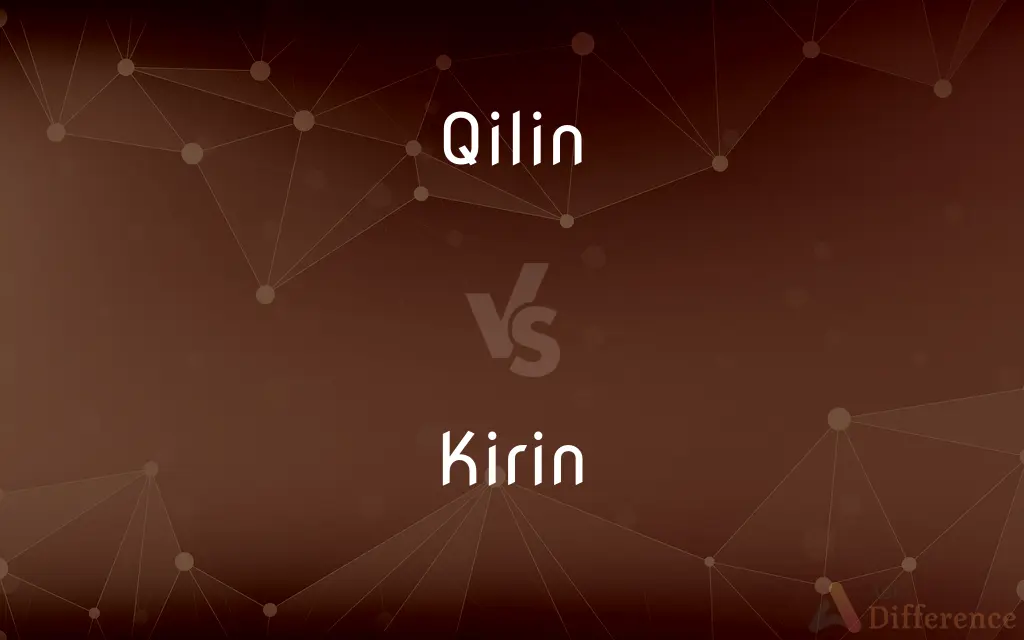Qilin vs. Kirin — What's the Difference?
By Urooj Arif & Maham Liaqat — Updated on March 4, 2024
Qilin, a mythical creature in Chinese culture, symbolizes prosperity and serenity, featuring a dragon-like appearance. Kirin, its Japanese counterpart, shares similar auspicious meanings but is depicted with more deer-like qualities.

Difference Between Qilin and Kirin
Table of Contents
ADVERTISEMENT
Key Differences
Qilin, in Chinese mythology, is often portrayed with a dragon's head, scales of a carp, and the hooves of a deer, symbolizing good luck, prosperity, and justice. Whereas Kirin, in Japanese culture, represents a creature of purity and peace, often depicted with a gentler appearance, having a deer's body and a dragon's head, but with a softer, more ethereal quality.
The Qilin is said to appear with the imminent arrival or passing of a sage or illustrious ruler, making it a symbol of the benevolent exercise of power and good governance. On the other hand, Kirin is believed to appear only in places ruled by a benevolent and virtuous leader, emphasizing its association with peace and purity rather than direct governance.
Qilin is deeply embedded in Chinese folklore and art, representing a myriad of virtues, including fertility, and is often depicted in various forms of traditional Chinese art. Kirin, while also significant in Japanese culture, tends to be associated more specifically with the brewing of beer and as a symbol in corporate branding, reflecting its adaptation into modern contexts.
Qilin's imagery and mythology have evolved over centuries, influenced by various dynasties and cultural exchanges within Asia, leading to a rich tapestry of stories and representations. Kirin, although derived from the same mythical roots, has been interpreted through the lens of Japanese culture, leading to unique variations in its mythological and artistic representations.
Despite their shared origins, the interpretations and symbolism of Qilin and Kirin vary significantly across different Asian cultures, reflecting the diversity and richness of the continent's folklore. This demonstrates how a single mythical concept can diverge into distinct cultural icons, each embodying the values and aesthetics of their respective societies.
ADVERTISEMENT
Comparison Chart
Appearance
Dragon's head, carp's scales, deer's hooves
Deer-like body, dragon's head, more ethereal
Symbolism
Good luck, prosperity, justice
Purity, peace
Cultural Significance
Appears with sage/ruler, symbol of good governance
Appears under virtuous leadership, associated with modern brands
Representation in Art
Varied across dynasties, rich in folklore
Influenced by Japanese aesthetics, modern adaptations
Mythological Origins
Ancient Chinese mythology, diverse stories
Derived from Chinese Qilin, unique Japanese interpretations
Compare with Definitions
Qilin
A mythical beast symbolizing good fortune.
The emperor believed the appearance of a Qilin predicted his prosperous reign.
Kirin
Symbolizes virtuous leadership.
A Kirin sculpture stands in the temple, representing the ideal ruler.
Qilin
Associated with serenity and prosperity.
The Qilin is often depicted in tranquil gardens to attract good luck.
Kirin
Associated with Japanese mythology.
The Kirin, though originating from Chinese lore, is a distinct part of Japanese myths.
Qilin
Represents the arrival of a sage.
Legends say a Qilin appeared at the birth of Confucius, heralding his wisdom.
Kirin
Adapted into modern culture.
Kirin beer uses the mythical beast as its logo, symbolizing quality.
Qilin
An emblem of wise leadership.
Artisans crafted a Qilin statue to honor the just rule of their leader.
Kirin
A creature denoting peace and purity.
The Kirin is revered in Japan as a guardian of peace.
Qilin
Featured in Chinese art and folklore.
The Qilin appears in ancient scrolls, symbolizing a harmonious empire.
Kirin
Portrayed with gentle features.
Paintings of the Kirin emphasize its calm and benevolent nature.
Qilin
The qilin ([tɕʰǐ.lǐn]; Chinese: 麒麟) or kirin is a mythical hooved chimerical creature that appears in Chinese mythology, and is said to appear with the imminent arrival or passing of a sage or illustrious ruler. Qilin are a specific type of the lin mythological family of one-horned beasts.
Qilin
A mythical Chinese hooved chimerical creature, said to appear in conjunction with the arrival of a sage.
Common Curiosities
What does the Kirin represent?
In Japanese culture, the Kirin represents peace and purity, often depicted as a creature with a deer's body and a dragon's head.
How are Qilin and Kirin depicted differently?
Qilin is depicted with scales and hooves, symbolizing prosperity, whereas Kirin is more deer-like, symbolizing purity.
Where does the Qilin appear in culture?
The Qilin appears in Chinese folklore, art, and mythology, often associated with the arrival of a sage or illustrious ruler.
What is the Qilin?
The Qilin is a mythical creature from Chinese culture symbolizing good fortune and justice, often depicted with a dragon's head and the hooves of a deer.
Can Qilin and Kirin be considered the same creature?
While they share origins, Qilin and Kirin have evolved differently in Chinese and Japanese cultures, symbolizing various virtues.
Why is Kirin important in modern Japan?
Beyond its mythological significance, Kirin has been embraced in modern Japan, notably in corporate branding like Kirin Brewery.
How does Kirin's symbolism affect its portrayal in art?
Kirin's symbolism of purity and peace influences its portrayal in Japanese art, often depicted with gentler, more ethereal features.
Are there different versions of Qilin in Chinese history?
Yes, depictions and stories of Qilin have varied across different dynasties, reflecting the changing values and aesthetics of Chinese culture.
What role does the Qilin play in Chinese ceremonies or traditions?
In some traditions, Qilin statues or motifs are used in ceremonies to attract good luck and prosperity, or to honor wise and just leadership.
What is the significance of Kirin in Japanese culture?
Kirin is significant in Japanese mythology and culture, symbolizing virtuous leadership and is also adopted in modern branding.
What does the appearance of a Qilin signify?
The appearance of a Qilin is believed to predict the arrival of leader, symbolizing good governance.
What virtues does the Qilin embody?
The Qilin embodies virtues such as good luck, prosperity, and justice, reflecting its significance in Chinese mythology.
How does Kirin's depiction differ from traditional to modern contexts?
While traditionally depicted with mythological attributes, Kirin's modern portrayals often emphasize peace and purity, even in commercial branding.
How has the Kirin influenced popular culture in Japan?
Kirin has significantly influenced Japanese popular culture, not only in mythology but also in modern branding and imagery, symbolizing quality and purity.
Why do Qilin and Kirin have different cultural significances?
The differences arise from their adaptations and interpretations within the distinct cultural, historical, and social contexts of China and Japan.
Share Your Discovery

Previous Comparison
Adrenaline vs. Cortisol
Next Comparison
Coefficient vs. ConstantAuthor Spotlight
Written by
Urooj ArifUrooj is a skilled content writer at Ask Difference, known for her exceptional ability to simplify complex topics into engaging and informative content. With a passion for research and a flair for clear, concise writing, she consistently delivers articles that resonate with our diverse audience.
Co-written by
Maham Liaqat















































